What we would do
We are no longer building saddle trees, but we have two videos about how Western saddles fit horses available on our westernsaddlefit.com website.
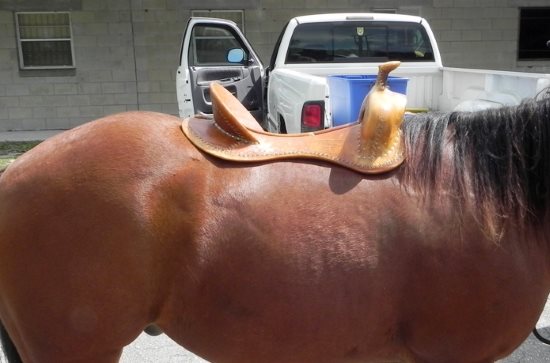
So, now that you have had time to look at the pictures and decide what you would do differently with a tree to fit this horse, here’s our responses. Pictures are good, but they aren’t as good as seeing something yourself, and sometimes you still don’t really have good answers on some things. But here’s what we are thinking at this point.
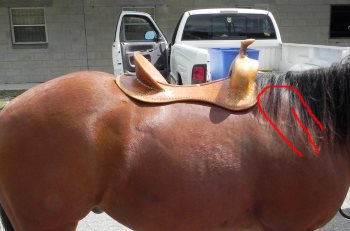 |
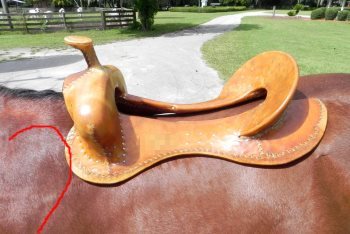 |
First thing to check out is if the tree is in the proper position. If it isn’t, then we can’t tell anything for sure since the shape of the horse and the shape of the bar won’t correspond when the tree is in the wrong place on the horse. So we check out where the shoulder blade is (in this post I described how to see where the shoulder blade is on the horse) and if the front bar tip is just behind it. In this case – yes, the tree is positioned properly, so we can look further at the fit.
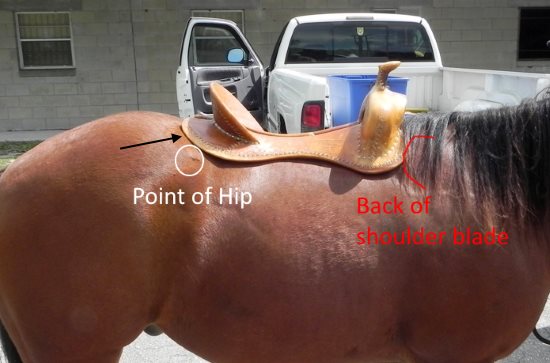
The first thing that struck us when we looked at this picture was how short backed the horse is. We know that the bars on this tree are just over 24” long – our maximum length – and that they are too long for this horse. (A shoulder to hip measurement – from the back of the shoulder blade to the point of the hip - is really helpful for comparing between horses, and this horse’s measurement will be short.) On horses with a rise into the croup – which is most of our quarter horse types – too-long bars will dig in at the back, and these ones do. See arrow. This is going to lift the back of the tree up and affect how the rest of it looks on the horse as well. So we know that the bars need to be shorter.
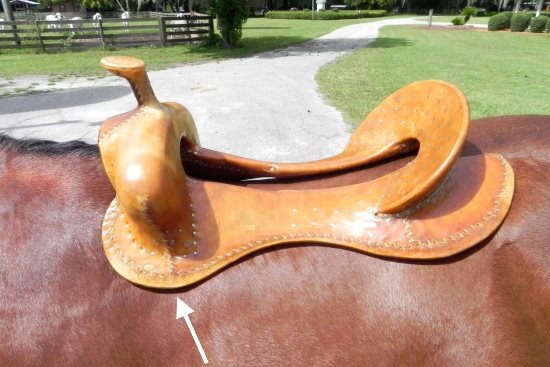
If the position is correct and the bar length is OK, then bar spread and angle are the next things to check. For this, we check out the front bar pads since this is the area of bar that the spread and angle set. The middle and back of the tree are affected by the bar spread and angle, but differing rock and twist change how they fit even with the same angle, so you can’t check the back of the tree to decide about bar angle. Looking from the side, the bottom edge of the front bar pad looks to be lifting off the horse because you can see shadow underneath it. So you may expect that the angle is adequate or even a bit too much. After all, if the bottom edge is lifting off, doesn’t that mean there is too much angle? Not necessarily.
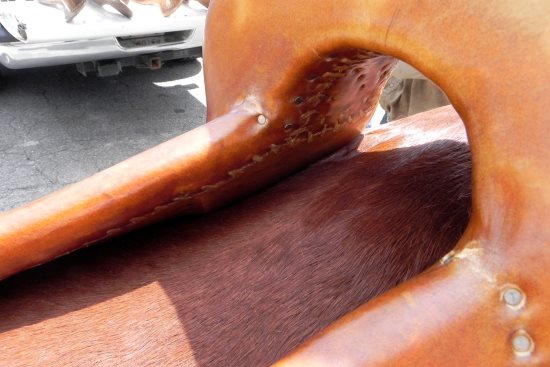
Remember, ya gotta look inside. This is one of the reasons trees or forms with built in groundseats are harder to evaluate – you can’t see areas that are important in evaluating fit. And when we look inside, we can see a whole lot of the underside of the bar. Since we can see it, it isn’t contacting the horse, and that’s not good. (It is hard to get a good picture of what the inside looks like, and we have to congratulate the saddle maker on getting a really good picture here.)
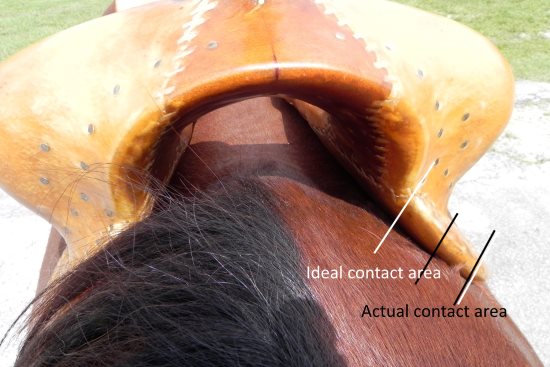
When you look at it from the front, you can see there is only a relatively small area of the front bar pad that is contacting the horse. There are two reasons for this. The first, and the one that will make the biggest difference if it is changed, is the bar angle. Now, we’re comparing two curved surfaces, so there is no way you can measure an angle on curved surfaces. Even if you could, remember that you can’t compare angles between makers by the numbers. But you can sure see when the angles are off! In this case, the horse’s withers have a much flatter angle than the bars do, which means the bars are too steep for this horse. So - the bar angle needs to be wider to get decent contact down the width of the bar.
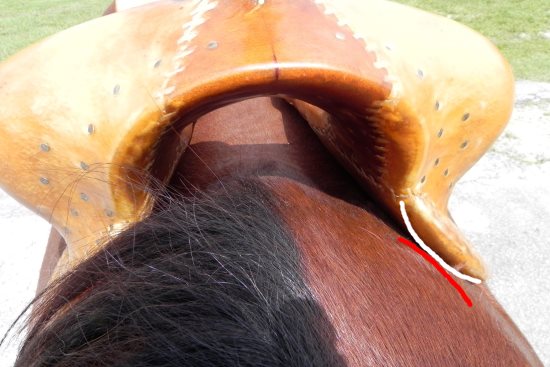
The other thing that affects the amount of contact area is the crown (curve side to side) on the bar. Now, you need some crown on the bars at all times. A dead flat bar on the front will end up with edges that dig in unless the “angle” is pretty much perfect. That rounding will give good relief to the edges of the bars. But when you get withers that are flat or even convex, you need as flat a crown on the bars as possible without digging in on the edges. So flattening the crown will help this horse too. Note: it is the crown on the bottom of the bar and the relief built into the edges that cause that shadow under the edge of the bar that you see on the side view. Don’t let that fool you into thinking the angle is adequate. (My white line on this picture exaggerates the real curve on the bar, but it just goes to prove I'm not perfect...)
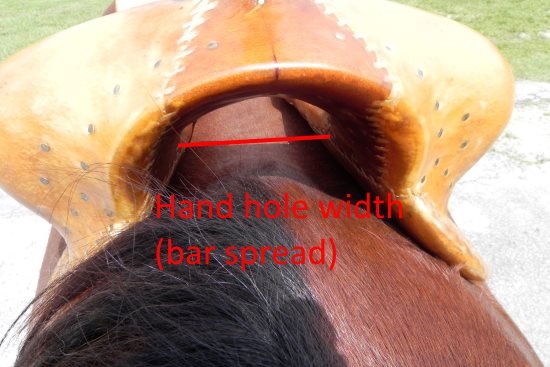
What about bar spread? Looking at the front, there is more than adequate clearance for the spine, and the bars are in a nice position on the withers height wise. Too narrow, and the bars sit high on the horse. Too wide, and the front “falls down” and the bars sit low. Here, they are just right – so we recommend keeping this bar spread.
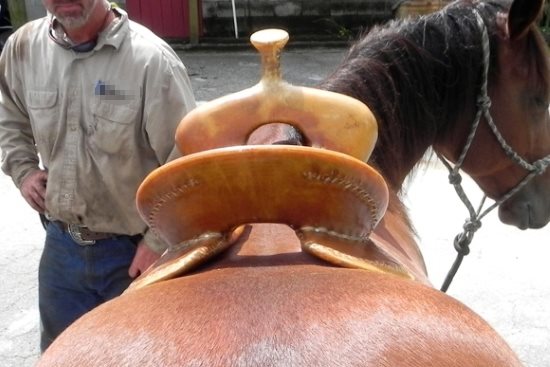
Looking from the back confirms that the bar spread is good. Lots of clearance for the spine between the bars. The angle at the back, however, is also too steep on the tree compared to the horse. You can see how the bottom edge of the bar contacts and the top edge is lifted off. So do we add more twist? Not necessarily. Remember, we will be increasing the bar angle, and that will increase the angle all along the bar. Adding extra twist will likely give too much angle to the back of the bars. Now, if the front of the bars were fine and the back of the bars looked like this, then adding twist would be a good idea. But since they aren’t, it isn’t.
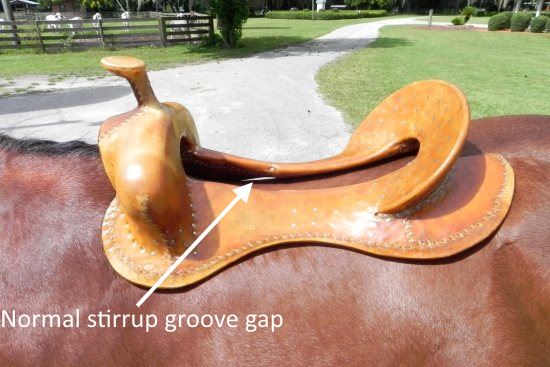
How about rock? We know the back of the bars are contacting, so there isn’t too much rock. But is there bridging? Well, in this view, there is the normal gap through the stirrup groove for the stirrup leather but no visible gap behind it. However, the picture isn’t taken at the correct angle to really show us if there is full contact along the length of the bar. Also, with the length of bar on this short horse, the way the back of the bars are contacting the croup could be lifting the middle of the tree, whereas with the correct bar length that wouldn’t happen. So we can’t tell about rock from these pictures.
Another thing we can’t tell is the angle of the bars in the center, just behind the stirrup groove. This is often an area where the bars are too steep, and while we can see that the inside edge of the bar is off the horse more than we would like, we just don’t have a good enough picture to tell how close the angle really is.
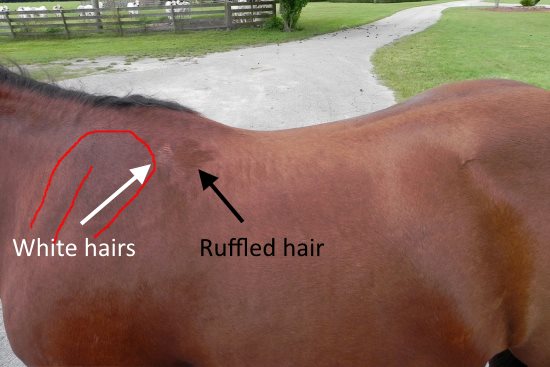
So, what can we tell from the two pictures we have of the bare horse? This picture is taken a bit from above. It would have been better directly from the side. Also, we don’t have the whole horse in the picture so there are some things we can’t tell. Like how much rock he has in his back, and is he downhill? (Does his back under the bars slope forward?) We don’t know, but there are indications that this could be the case. What am I talking about? Those white hairs at the back of the shoulder blade – right where the back of the shoulder blade moves. They are evidence that there has been damage to the horse for some reason. Reason number one in that spot is saddle pressure. But there can be a couple of causes for that pressure. One is a very downhill horse with gravity pulling the saddle forward onto the shoulder blades. Two is the rider positioning the saddle up on the shoulder blades. We don’t know how or where or why those hairs changed color – just that they have.
Something else to note as well is the ruffled hair behind that. Again, not sure why it is there. It could be as simple as someone rubbing the hair the wrong way just before the picture was taken, so we don’t want to draw major conclusions from it. But it is something to be noted, as ruffled hair seen when removing a saddle generally indicates rubbing or movement of some kind under the saddle.
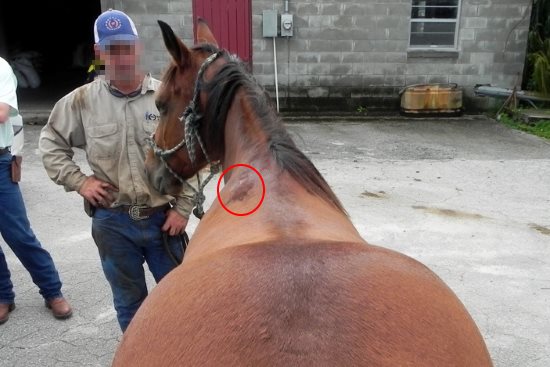
And from the back? Well, we can tell that yup, he is pretty wide and flat all the way down. That sure fits with what we see when we compare the tree to the horse.
But that spot at the back of his shoulder blades is still there. In this view it looks more like a raised area, but again, you can’t say anything for sure from just a picture. So, how would someone who is there check it out? Well, what does it feel like? Is it raised or not? Does the hair smooth down or not? Is there any heat or pain? Does the horse react when you touch or push on it, and how does this fit with the temperament of this horse? (Some horses flinch if you just look at them and some horses don’t show a lot of pain with severe injury, so knowing the horse helps in interpreting their reaction to pain.) Is it soft? Hard? Can you make a dent in it? Does the dent stay for a while or spring back quickly? Questions like these help determine if it is just ruffled hair or swelling under the skin or a long term lump or scar tissue from previous injury, etc.
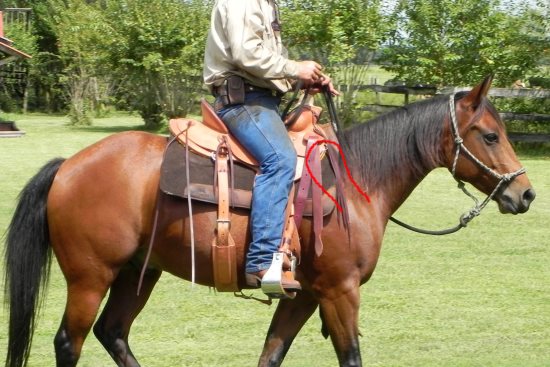
But all the changes we make won’t help if this is how the horse is saddled with the new tree… The saddle maker put the tree in the correct position behind the shoulder blade, but when the customer saddled up, you can see where he put the saddle. I drew the shoulder blade in to the best of my ability in the picture above. I am obviously no artist, but you can easily see that the saddle is sitting on top the shoulder blade. And when the saddle is out of position, the shapes just don’t match and there will be high pressure areas. That’s a given. So getting the proper position of the saddle is vital. Misplacing the saddle like this is an extremely common situation causing a lot of problems for a lot of horses and it could easily be the cause of the white and ruffled hair we discussed previously. The more we look, the more we see this happening, so we’ll talk about this again in future posts…
